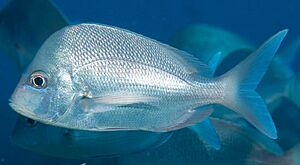Slinger seabream facts for kids
Quick facts for kids Slinger seabream |
|
|---|---|
 |
|
| Conservation status | |
| Scientific classification | |
| Synonyms | |
|
The slinger seabream, known scientifically as Chrysoblephus puniceus, is a type of ray-finned fish. It belongs to the family called Sparidae, which includes many seabreams and porgies. This fish lives only in the southwestern Indian Ocean, especially near Southern Africa.
Contents
About the Slinger Seabream
How it Got its Name
The slinger seabream was first officially described in 1908. Two scientists, John Dow Fisher Gilchrist from Scotland and William Wardlaw Thompson from South Africa, gave it its scientific name. They found it near KwaZulu-Natal, South Africa.
The second part of its scientific name, puniceus, means "reddish." This name was chosen because the fish has a beautiful pink color.
What the Slinger Seabream Looks Like
The slinger seabream has a deep, flattened body. Its back fin, called the dorsal fin, has 11 strong spines and 10 soft rays. Its bottom fin, the anal fin, has 3 spines and 8 soft rays.
The top of its head slopes steeply from its mouth to its neck. The fish is mostly reddish-pink with hints of blue. Its fins are pink, and it has a thin blue line under its eyes. There is also a tiny black spot near its pectoral fin. Slingers can grow up to 85 centimeters (about 33 inches) long, but they are usually around 55 centimeters (about 22 inches).
Where the Slinger Seabream Lives
Slinger seabreams live in the southwestern Indian Ocean. You can find them from southern Mozambique down to Algoa Bay in the Eastern Cape of South Africa. They also live off the coast of southern Madagascar.
These fish prefer to live on rocky reefs far from shore. They are found at depths between 10 and 130 meters (about 33 to 426 feet). Younger slingers like shallower waters than the older, adult fish.
Life and Habits of the Slinger Seabream
Reproduction and Life Cycle
The slinger seabream has a special way of reproducing. It is a protogynous hermaphrodite. This means that all slingers are born female. When they are about 5 years old or reach 38 centimeters (about 15 inches) in length, some females change into males. These new males can then grow even larger, often up to 55 centimeters (about 22 inches).
What the Slinger Seabream Eats
Slinger seabreams are opportunistic predators, meaning they eat whatever food is available. Adult slingers mainly hunt for creatures that live on the ocean floor. Their diet includes crabs and shrimp (crustaceans), snails and clams (molluscs), and starfish and sea urchins (echinoderms).
Younger slingers eat smaller things. They prey on tiny crustaceans like decapods, amphipods, and copepods. They also eat small sea creatures like crinoids, brittle stars, and sea urchins.
Movement and Migration
Adult slinger seabreams usually stay in one area. However, there is evidence that young slingers migrate. They move north from the Eastern Cape to KwaZulu-Natal and southern Mozambique.
Slinger Seabream and Fishing
The slinger seabream is an important fish for commercial fishing. In KwaZulu-Natal, it makes up a large part of the total fish caught, sometimes between 25% and 50%.
Because only the larger, older fish are males, there was concern in the 1990s that too much fishing could harm the population. The number of slingers did drop a lot by the late 1990s. However, since then, the population has shown a good recovery, increasing by about 30%.


